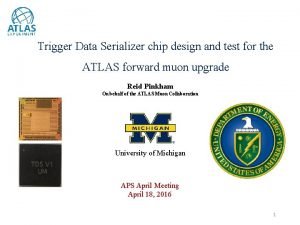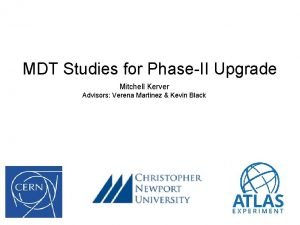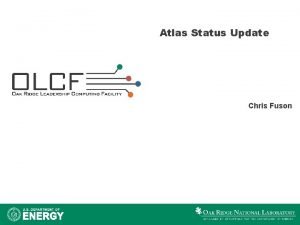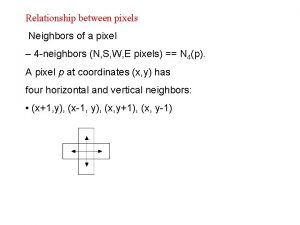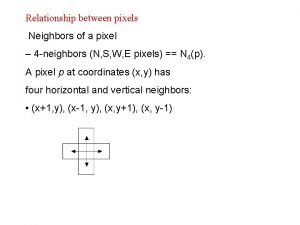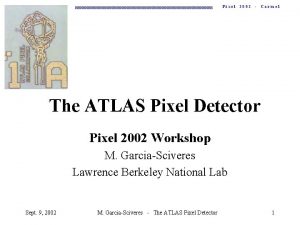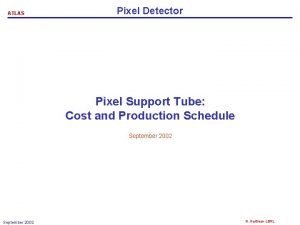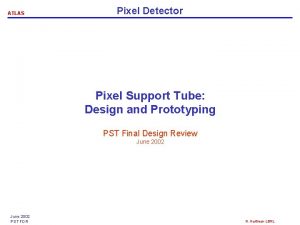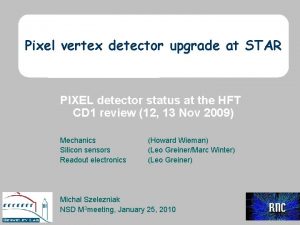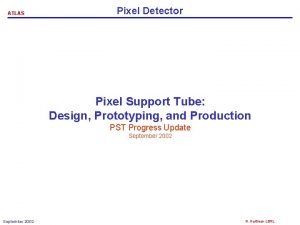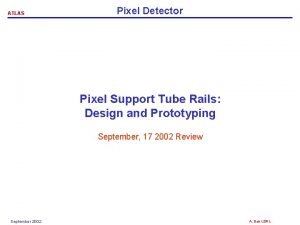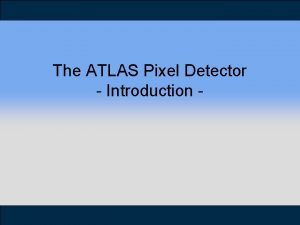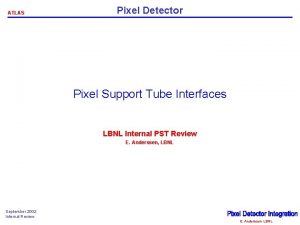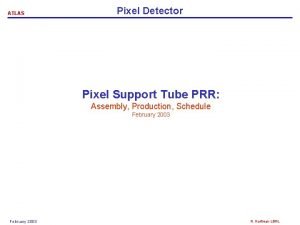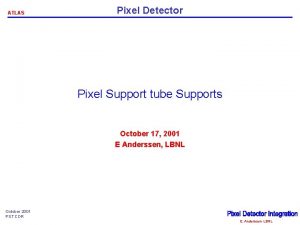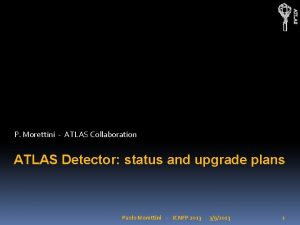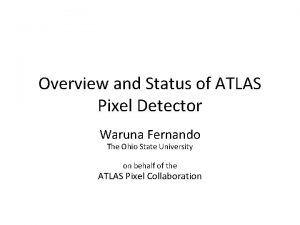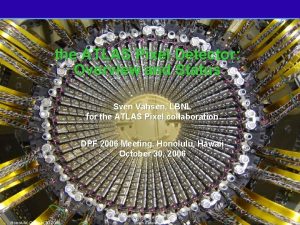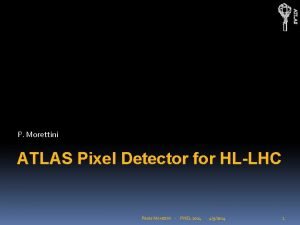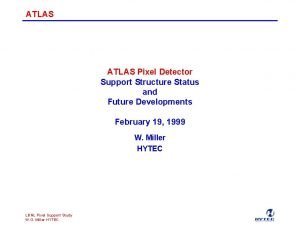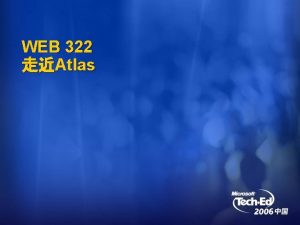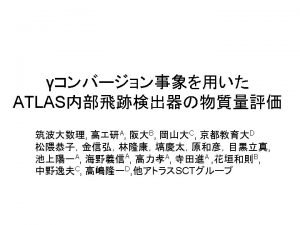Overview and status of the ATLAS Pixel Detector





















- Slides: 21

Overview and status of the ATLAS Pixel Detector Attilio Andreazza Università di Milano and I. N. F. N. for the ATLAS Pixel Collaboration • Layout of the ATLAS Pixel Detector • Commissioning activities: – system test setup – measurement with cosmics on surface • Installation in ATLAS HEP 2007 Manchester, 19 July 2007 A. Andreazza - Status of the ATLAS Pixel Detector s few cs t s Ju pi o t ted c e l e

A Toroidal LHC Apparatus HEP 2007 Manchester, 19 July 2007 A. Andreazza - Status of the ATLAS Pixel Detector 2

The ATLAS Pixel Detector • • B-Layer-1 B-Layer Disks • • • Beampipe HEP 2007 Manchester, 19 July 2007 The Pixel Detector is the vertex detector for the ATLAS experiment. It consists of three barrel layers and six disks, covering with three precise measurement points the region up to 2. 5. Innermost layer (B-layer) at R=5 cm There will be 1456 barrel modules and 288 forward modules, for a total of 80 million channels and a sensitive area of 1. 6 m 2. Modules will operate in an environment temperature below 0ºC and within a 2 T solenoidal magnetic field. Barrel module are tilted by 20º in the R plane to overcompensate the Lorentz angle. Components have been tested to be radhard up to: – – NIEL > 1015 1 Me. V n/cm 2 dose > 500 k. Gy A. Andreazza - Status of the ATLAS Pixel Detector 3

Module concept • • 60. 8× 16. 4 mm 2 × 250 m active silicon volume. 50 m (R ) × 400 m ( ) pixels Bump bonds between sensor and 16 front-end electronics chips (both Sn. Pb and In bumps used) Module Controller Chip on flex hybrid to perform distribution of commands and event building. HEP 2007 Manchester, 19 July 2007 • Each channel can be individually tuned, to get uniform response: – threshold: 4000 e– threshold dispersion: 40 -90 e– noise: 140 -180 e- • Defective pixels – – Layer 2: Layer 1: B-Layer: Disks: 0. 29% 0. 20% 0. 07% 0. 20% A. Andreazza - Status of the ATLAS Pixel Detector 4

Timing in the pixels electronics • • Ideal pulse shape is almost triangular with fast rise and slow return to baseline. Timing of this signal is critical 1. Timewalk: • low pulse height signals arrive later than high pulse height; • if delay is too high, the pulse is associated to the subsequent bunch crossing. • uniform efficiency requires good synchronization. 2. Time over Threshold (To. T) • used to interpolate position of multi-hit clusters as a function of =Q 2/(Q 1+Q 2) • Time over Threshold for a m. i. p. tuned to 30 clock cycles 20 ns In-time threshold 1 m. i. p. timewalk To. T HEP 2007 Manchester, 19 July 2007 A. Andreazza - Status of the ATLAS Pixel Detector 5

System test setup • Commissioning of one full pixel detector endcap: – 144 modules • Almost final services: – LV supply + rad-tolerant regulation system; – operation at -10 ºC, using evaporative cooling; – connection to off-detector readout electronics via optical fibres. Service quarter panel • Goals: – test of services – setting up in-situ calibration tools – commissioning of DAQ – commissioning of the detector with cosmics ray and noise runs. HEP 2007 Manchester, 19 July 2007 Pixel endcap A A. Andreazza - Status of the ATLAS Pixel Detector 6

System test: optical links • Connection between on- and off-detector readout electronics is through optical link. Each link can be tuned by setting: – – • • but size of error free region depends on the bias: one value for 7 channels. Experience from system test operation: – – • signal phase threshold dynamic range of channels is sensitive to temperature matching of the 7 channels is not adequate at the design temperature. clock edge Pi. N threshold [DAC] • 1 0 error free region Action: – install heaters to keep optobards at room temperature. HEP 2007 Manchester, 19 July 2007 0 1 phase [ns] A. Andreazza - Status of the ATLAS Pixel Detector 7

Cosmics data-taking • Standalone running using the system test setup in December 2006: – Full Endcap A (144 modules, 112 readout) – trigger scintillator system (1 to 4 in the picture): 3 AND ( 1 OR 2 OR 4 ) – 20 cm iron block to provide a 230 Me. V/c momentum cut. • • Huge amount of random trigger data About 1 M cosmics trigger – 4% with reconstructed tracks through all three disks • Reference data for validation of pixel detector understanding HEP 2007 Manchester, 19 July 2007 A. Andreazza - Status of the ATLAS Pixel Detector 8

Cosmics data: module syncronization Hits in time with trigger ns Delay VS module number 10 ns Disk 0 ns Flat noise distribution ns Disk 1 • • Disk 2 HEP 2007 Manchester, 19 July 2007 • Timewalk spreads hits through different “bunch crossings” This distribution is sensitive to module timing. Checked module synchronization with resolution better than 1 ns. A. Andreazza - Status of the ATLAS Pixel Detector 9

Cosmics data: noise measurements • • • Occupancy: hit probability per bunch crossing of a pixel. Typical occupancy rate in noise runs is 1 -3 10 -8 per bunch crossing Noise is concentrated on few hot pixels: – ~90% are special pixels, marked during module characterization, – remaining can be removed with an additional masking step. • True random occupancy is order of 10 -10 Occupancy Signal Noise After masking 89 (out of 1. 6× 106) pixels with occupancy greater than 10 -4 10 -10 HEP 2007 Manchester, 19 July 2007 A. Andreazza - Status of the ATLAS Pixel Detector 10

Cosmics data: efficiency • Efficiency can be computed using particles which crosses overlapping modules in the same disk – 24% of tracks * • fiducial cuts on both the initial and overlapping module (remove shallow tracks) • Average efficiency ~99% • not enough statistics to provide accurate per module measurement. Disk 0 HEP 2007 Manchester, 19 July 2007 Disk 1 Disk 2 A. Andreazza - Status of the ATLAS Pixel Detector 11

Cosmics data: resolution 50 m pitch resolution = 21 m 50 m pitch resolution = 18 m 400 m pitch resolution = 117 m alignment • • Due to the low extrapolation distance, overlap residuals are good for testing detector resolution and alignment. Low momentum tracks and high incidence angles, results in not-optimal resolution: – MC expectation is 16 m for the precision coordinate (~9 m for high momentum/normal incidence tracks) – After a simple alignment the observed resolution in data matches well with MC expectation. HEP 2007 Manchester, 19 July 2007 A. Andreazza - Status of the ATLAS Pixel Detector 12

Installation: the last tests • Final part of the assembly performed on surface: – connection of all the services – test of leak tightness and conductor continuity – 2. 5 monthes of hard work to fully check the detector before installing in ATLAS. As built detector quality: • Localised inefficiencies – 2 unusable modules – 3 dead FE chips – total of 0. 12% localized inefficiencies – None of these in the B-layer! • Individual bad pixels 0. 2% – Only 0. 07% in B-layer – Most relevant failures: • disconnected bumps • noisy channels • reduced charge collection HEP 2007 Manchester, 19 July 2007 A. Andreazza - Status of the ATLAS Pixel Detector 13

. . . and then diving • Pixel Package Lowered; 25 June • Pixel Package Installed; 29 June HEP 2007 Manchester, 19 July 2007 A. Andreazza - Status of the ATLAS Pixel Detector 14

Conclusions • The ATLAS Pixel detector construction has been completed • Detailed information of each of the 80 M channels: – the fraction of defective pixels is below 0. 4% • The full pixel package has been installed in the heart of ATLAS. • Unfortunately final connection to the services will not be possible until Fall: operation only in Winter. • One endcap has been used for system commissioning: – matching of optical components proved to be critical – reconstruction and simulation software validated using cosmics rays: • noise occupancy O(10 -10) • efficiency >99% • resolution matches MC expectation. HEP 2007 Manchester, 19 July 2007 . . . to. Sleeping be awakened bywaiting As Beauty a cosmics’ kiss for Prince Charming A. Andreazza - Status of the ATLAS Pixel Detector 15

Back-up transparencies HEP 2007 Manchester, 19 July 2007 A. Andreazza - Status of the ATLAS Pixel Detector

System test: evaporative cooling Switching on cooling Module calibration, T -10 ºC Switching off cooling Modules in stand by, T 18 ºC • The evaporative cooling system is critical for operation of the detector at low temperature (needed to reduce impact of radiation damage). • It operated for the whole period with high reliability. HEP 2007 Manchester, 19 July 2007 A. Andreazza - Status of the ATLAS Pixel Detector 17

Front-end electronics concept • • • Fast charge amplifier with constant current feedback. Fast discriminator with tunable threshold (7 -bit DAC) Storage of hits during the trigger latency time in 64 “End of Column” memory buffers for each column pair of 2× 160 pixels HEP 2007 Manchester, 19 July 2007 A. Andreazza - Status of the ATLAS Pixel Detector 18

Module concept • • Self-consistent detector unit. Sensor (Oxygenated FZ Silicon): – – Module Controller Chip Flex hybrid • Front-end electronics: – – 16 FE chips Sensor • Solder (IZM, Berlin) Indium (Selex, previously AMS, Rome) Flex hybrid: – Pigtail 16 FE-I 3 chips, 0. 25 m IBM technology, with rad-hard design; 46080 channels/module Interconnection by bump-bonding: – – • active area 60. 8 × 16. 4 mm 2 250 m thickness pixel cell 50 m (R ) × 400 m (Z) extended cells (ganged and long pixels) to cover the otherwise dead region between FE chips. – Module Controller Chip to perform communication and event building; local decoupling and temperature monitoring. HV connection HEP 2007 Manchester, 19 July 2007 A. Andreazza - Status of the ATLAS Pixel Detector 19

Specifications Radiation hardness: • NIEL > 1015 1 Me. V neq/cm 2 • 500 k. Gy Technical Design Report specification were: • R resolution 13 m, • efficiency better than 97% at end of lifetime, • analog information was a high priority option. Given the 25 ns beam crossing rate at the LHC: • must be able to assign each hit to the proper bunch crossing; (measuremens of timewalk effects on efficiency and resolution) • must be able to store the hit information during the trigger latency time of ~100 beam crossings. (measuremens of rate capability of the readout system with high intensity beam) HEP 2007 Manchester, 19 July 2007 A. Andreazza - Status of the ATLAS Pixel Detector 20

To. T measurements Single hit clusters • To. T for clusters associated to tracks for single, double and triple hits – red isto: MC – blue crosses: cosmics data • Two hits clusters To. T Using calibration constants – from production measurements – read from DB • • Noise suppressed Calibration data from production measurements appears to describe cosmics data well Three hits clusters To. T HEP 2007 Manchester, 19 July 2007 A. Andreazza - Status of the ATLAS Pixel Detector 21
 Txp100
Txp100 Atlas detector
Atlas detector Atlas status 2014
Atlas status 2014 4-neighbors and 8 neighbors of a pixel example
4-neighbors and 8 neighbors of a pixel example 4 neighbors and 8 neighbors of a pixel
4 neighbors and 8 neighbors of a pixel Hình ảnh bộ gõ cơ thể búng tay
Hình ảnh bộ gõ cơ thể búng tay Ng-html
Ng-html Bổ thể
Bổ thể Tỉ lệ cơ thể trẻ em
Tỉ lệ cơ thể trẻ em Gấu đi như thế nào
Gấu đi như thế nào Thang điểm glasgow
Thang điểm glasgow Hát lên người ơi alleluia
Hát lên người ơi alleluia Môn thể thao bắt đầu bằng từ đua
Môn thể thao bắt đầu bằng từ đua Thế nào là hệ số cao nhất
Thế nào là hệ số cao nhất Các châu lục và đại dương trên thế giới
Các châu lục và đại dương trên thế giới Cong thức tính động năng
Cong thức tính động năng Trời xanh đây là của chúng ta thể thơ
Trời xanh đây là của chúng ta thể thơ Mật thư tọa độ 5x5
Mật thư tọa độ 5x5 Làm thế nào để 102-1=99
Làm thế nào để 102-1=99 độ dài liên kết
độ dài liên kết Các châu lục và đại dương trên thế giới
Các châu lục và đại dương trên thế giới Thơ thất ngôn tứ tuyệt đường luật
Thơ thất ngôn tứ tuyệt đường luật
